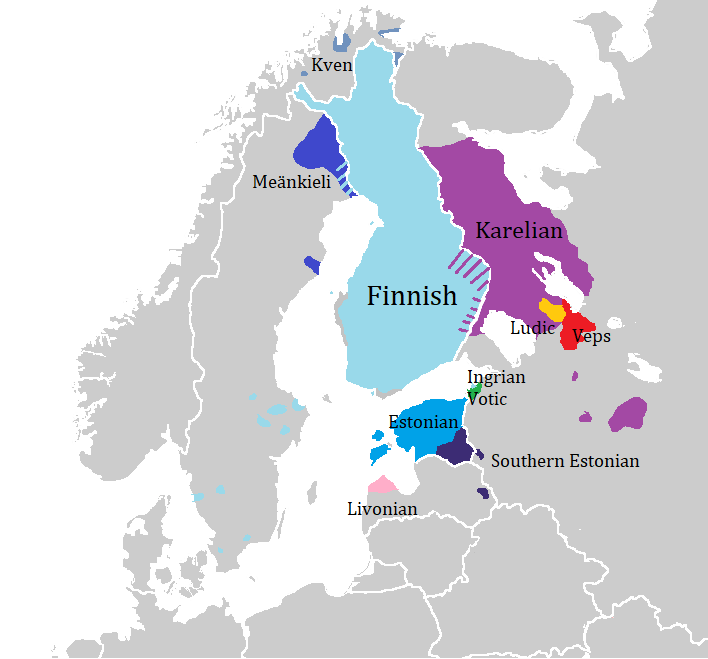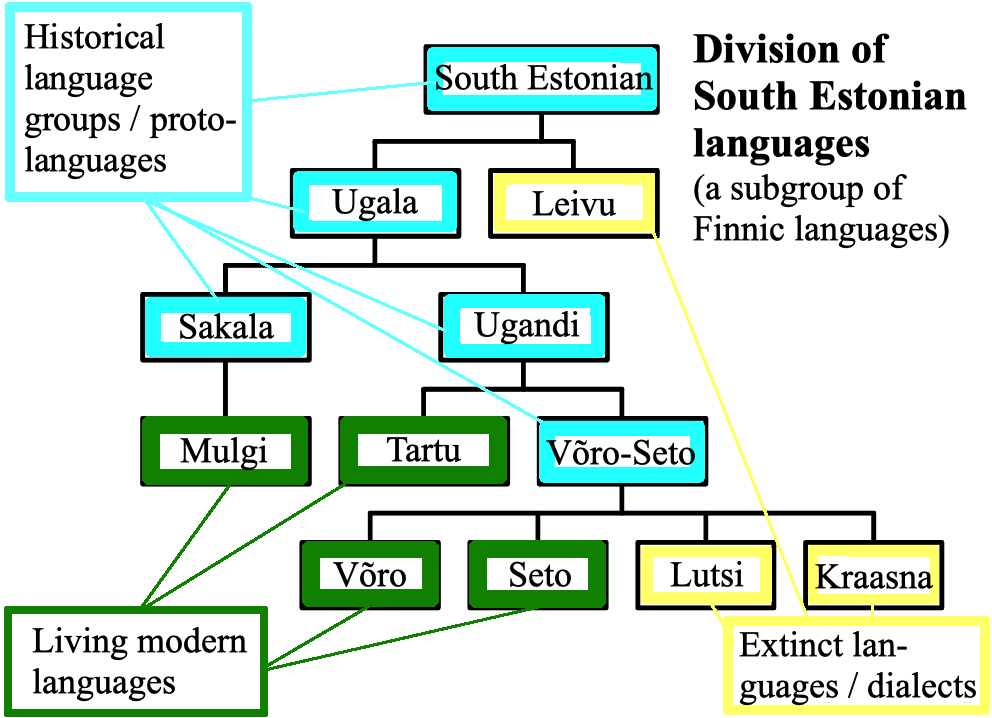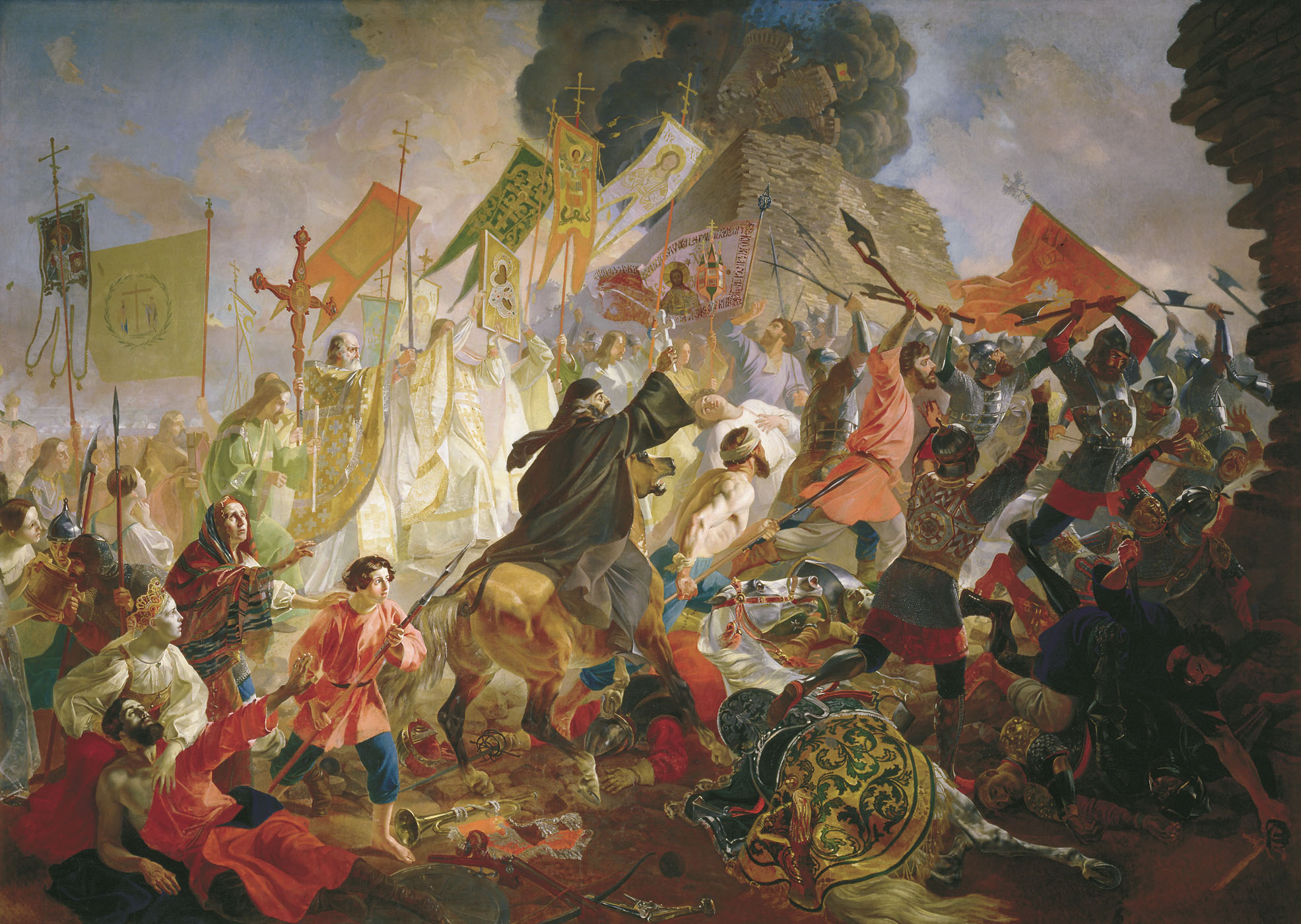|
Kraasna Dialect
Kraasna is an extinct South-Estonian dialect spoken in Russia by the Kraasna Estonians who were immigrants to the area. The last native speaker died before World War two, but it was still spoken in the 1930s. Kraasna was documented by Oskar Kallas (along with Ludza). The linguistic enclave was south of the Russian city of Pskov. Kraasna, like the Seto dialect, have been influenced by Russian. The Kraasna dialect was first discovered in the year 1849 when F.R. Kreutzwald sent a letter to A.J. Brandt. The Kraasna Estonians arrived to the area at the end of the 16th century which was close to eastern Seto, but had slight influence from Võro. The Kraasna dialect had an abessive suffix -ldA and the translative marker -st which are linked to Seto. Example {{Poemquote , text={{lang, fiu-RU, Mis om madalamb ma ja pikkemb muist puist? viŋgjäl tseal om mittu vikka kas om ma külmäne vai om kärz haige mis peettäs si̮nast ja härg sarvist vaiv vanas sajja, vanah hüä elo jalg ... [...More Info...] [...Related Items...] OR: [Wikipedia] [Google] [Baidu] |
Kraasna
Krasnogorodsk (russian: Красногородск; et, Kraasna) is an urban locality (a work settlement) and the administrative center of Krasnogorodsky District of Pskov Oblast, Russia, located on the Sinyaya River south of Pskov. Municipally, it is incorporated as Krasnogorodsk Urban Settlement, the only urban settlement in the district. Population: History Krasnogorodsk was founded in 1464 as Krasny Gorodets and was a fortress protecting Pskov from the southwest - one of the directions the Livonian Order was likely to advance from. In the beginning of the 15th century, together with Pskov, it was transferred to the Grand Duchy of Moscow. In 1581, Krasny Gorodets was conquered by the Polish Army and burned down. In 1607, it was again conquered by Lithuanians. In 1634 a peace between Russia and Poland was concluded, and the Krasny Gorodets was transferred to the Polish–Lithuanian Commonwealth. It was returned to Russia under one of the provisions of the Truce of Andruso ... [...More Info...] [...Related Items...] OR: [Wikipedia] [Google] [Baidu] |
Finno-Ugric Languages
Finno-Ugric ( or ; ''Fenno-Ugric'') or Finno-Ugrian (''Fenno-Ugrian''), is a traditional grouping of all languages in the Uralic language family except the Samoyedic languages. Its formerly commonly accepted status as a subfamily of Uralic is based on criteria formulated in the 19th century and is criticized by some contemporary linguists such as Tapani Salminen and Ante Aikio as inaccurate and misleading. The three most-spoken Uralic languages, Hungarian, Finnish, and Estonian, are all included in Finno-Ugric, although linguistic roots common to both branches of the traditional Finno-Ugric language tree (Finno-Permic and Ugric) are distant. The term ''Finno-Ugric'', which originally referred to the entire family, is sometimes used as a synonym for the term ''Uralic'', which includes the Samoyedic languages, as commonly happens when a language family is expanded with further discoveries. Status The validity of Finno-Ugric as a phylogenic grouping is under challenge, with s ... [...More Info...] [...Related Items...] OR: [Wikipedia] [Google] [Baidu] |
Finnic Languages
The Finnic (''Fennic'') or more precisely Balto-Finnic (Balto-Fennic, Baltic Finnic, Baltic Fennic) languages constitute a branch of the Uralic language family spoken around the Baltic Sea by the Baltic Finnic peoples. There are around 7 million speakers, who live mainly in Finland and Estonia. Traditionally, eight Finnic languages have been recognized. The major modern representatives of the family are Finnish and Estonian, the official languages of their respective nation states.Finnic Peoples at Encyclopædia Britannica The other Finnic languages in the Baltic Sea region are Ingrian and |
South Estonian
South Estonian, spoken in south-eastern Estonia, encompasses the Tartu, Mulgi, Võro and Seto varieties. There is no academic consensus on its status, as some linguists consider South Estonian a dialect group of Estonian whereas other linguists consider South Estonian an independent Finnic language. Diachronically speaking, North and South Estonian are separate branches of the Finnic languages. Note that reconstructed *č and *c stand for affricates , . Modern Standard Estonian has evolved on the basis of the dialects of Northern Estonia. However, from the 17th to the 19th centuries in Southern Estonia, literature was published in a standardized form of Southern Tartu and Northern Võro. That usage was called Tartu or literary South Estonian. The written standard was used in the schools, churches and courts of the Võro and Tartu linguistic area but not in the Seto and Mulgi areas. After Estonia gained independence in 1918, the standardized Estonian language policies we ... [...More Info...] [...Related Items...] OR: [Wikipedia] [Google] [Baidu] |
Kraasna Estonians
Krasnogorodsk (russian: Красногородск; et, Kraasna) is an urban locality (a work settlement) and the administrative center of Krasnogorodsky District of Pskov Oblast, Russia, located on the Sinyaya River south of Pskov. Municipally, it is incorporated as Krasnogorodsk Urban Settlement, the only urban settlement in the district. Population: History Krasnogorodsk was founded in 1464 as Krasny Gorodets and was a fortress protecting Pskov from the southwest - one of the directions the Livonian Order was likely to advance from. In the beginning of the 15th century, together with Pskov, it was transferred to the Grand Duchy of Moscow. In 1581, Krasny Gorodets was conquered by the Polish Army and burned down. In 1607, it was again conquered by Lithuanians. In 1634 a peace between Russia and Poland was concluded, and the Krasny Gorodets was transferred to the Polish–Lithuanian Commonwealth. It was returned to Russia under one of the provisions of the Truce of Andrusovo ... [...More Info...] [...Related Items...] OR: [Wikipedia] [Google] [Baidu] |
Ludza Dialect
The Ludza dialect or Lutsi () is a dialect of South Estonian spoken in Latvia by the Ludza Estonians near the town of Ludza in Latvia. Ludza is the most similar to the Seto dialect of South Estonian. The Ludza dialect has been on a decline and is now extinct. It was estimated that around 800 people spoke Ludza in the year 1894, and in 1936 this number had decreased to only around 30-40 people. The last native speaker of Ludza died in the year 2006 but some people still have small knowledge of the dialect. The last native speaker of the Ludza dialect was Nikolājs Nikonovs, who was from the village of Lielie Tjapši. The last knowledgeable passive speaker Antonīna Nikonova, died later in 2014. History The origin of the Ludza people is a mystery, and there are many theories about it. Lutsis themselves had many stories about their origins, one of the stories is about fleeing from Sweden. In 1893 Oskar Kallas found Ludzi speakers in 53 villages around Mērdzene, Pilda, Nirza an ... [...More Info...] [...Related Items...] OR: [Wikipedia] [Google] [Baidu] |
Enclave
An enclave is a territory (or a small territory apart of a larger one) that is entirely surrounded by the territory of one other state or entity. Enclaves may also exist within territorial waters. ''Enclave'' is sometimes used improperly to denote a territory that is only partly surrounded by another state. The Vatican City and San Marino, both enclaved by Italy, and Lesotho, enclaved by South Africa, are completely enclaved sovereign states. An exclave is a portion of a state or district geographically separated from the main part by surrounding alien territory (of one or more states or districts etc). Many exclaves are also enclaves, but not all: an exclave can be surrounded by the territory of more than one state. The Azerbaijani exclave of Nakhchivan is an example of an exclave that is not an enclave, as it borders Armenia, Turkey and Iran. Semi-enclaves and semi-exclaves are areas that, except for possessing an unsurrounded sea border (a coastline contiguous with interna ... [...More Info...] [...Related Items...] OR: [Wikipedia] [Google] [Baidu] |
Pskov
Pskov ( rus, Псков, a=pskov-ru.ogg, p=pskof; see also Names of Pskov in different languages, names in other languages) is a types of inhabited localities in Russia, city in northwestern Russia and the administrative center of Pskov Oblast, located about east of the Estonia, Estonian border, on the Velikaya River. Population: Pskov is one of the oldest cities in Russia. It served as the capital of the Pskov Republic and was a trading post of the Hanseatic League before it came under the control of the Grand Duchy of Moscow. History Early history Pskov is one of the oldest cities in Russia. The name of the city, originally Pleskov (historic Russian spelling , ''Plěskov''), may be loosely translated as "[the town] of :wikt:purling, purling waters". It was historically known in English as Plescow. Its earliest mention comes in 903, which records that Igor of Kiev married a local lady, Olga of Kiev, Olga (later Saint Olga of Kiev). Pskovians sometimes take this year as ... [...More Info...] [...Related Items...] OR: [Wikipedia] [Google] [Baidu] |
Seto Dialect
Seto (; et, setu keel) is a dialect of Estonian or a separate language spoken by 12,549 people. It is sometimes identified as a dialect of Võro, or the two are described as one language, Võro-Seto. Setos () mostly inhabit the area near Estonia's southeastern border with Russia in Setomaa, and are primarily Eastern Orthodox, while Võros () are traditionally Lutherans and live in historical Võru County. Language sample Article 1 of the Universal Declaration of Human Rights The Universal Declaration of Human Rights (UDHR) is an international document adopted by the United Nations General Assembly that enshrines the rights and freedoms of all human beings. Drafted by a UN committee chaired by Eleanor Roosevelt, ...: * Seto: * Võro: * Estonian: * Finnish: * English: ''All human beings are born free and equal in dignity and rights. They are endowed with reason and conscience and should act towards one another in a spirit of brotherhood.'' Refere ... [...More Info...] [...Related Items...] OR: [Wikipedia] [Google] [Baidu] |
Võro Dialect
Estonian ( ) is a Finnic language, written in the Latin script. It is the official language of Estonia and one of the official languages of the European Union, spoken natively by about 1.1 million people; 922,000 people in Estonia and 160,000 outside Estonia. Classification Estonian belongs to the Finnic branch of the Uralic language family. The Finnic languages also include Finnish and a few minority languages spoken around the Baltic Sea and in northwestern Russia. Estonian is subclassified as a Southern Finnic language and it is the second-most-spoken language among all the Finnic languages. Alongside Finnish, Hungarian and Maltese, Estonian is one of the four official languages of the European Union that are not of an Indo-European origin. From the typological point of view, Estonian is a predominantly agglutinative language. The loss of word-final sounds is extensive, and this has made its inflectional morphology markedly more fusional, especially with res ... [...More Info...] [...Related Items...] OR: [Wikipedia] [Google] [Baidu] |
Abessive Case
In linguistics, abessive (abbreviated or ), caritive and privative (abbreviated ) is the grammatical case expressing the lack or absence of the marked noun. In English, the corresponding function is expressed by the preposition '' without'' or by the suffix '' -less.'' The name ''abessive'' is derived from "to be away/absent", and is especially used in reference to Uralic languages. The name ''caritive'' is derived from la, carere, link=no "to lack", and is especially used in reference to Caucasian languages. The name ''privative'' is derived from la, privare, link=no "to deprive". In Afro-Asiatic languages Somali In the Somali language, the abessive case is marked by or and dropping all but the first syllable on certain words. For example: : "love" : "loveless" : "clothes" : "clothesless," i.e., naked In Australian languages Martuthunira In Martuthunira, the privative case is formed with either or . In Uralic languages Finnish In the Finnish language, the abes ... [...More Info...] [...Related Items...] OR: [Wikipedia] [Google] [Baidu] |
Leivu Dialect
The Leivu dialect is an extinct South-Estonian dialect that was spoken in North Latvia around the Gauja river spoken by the Gauja Estonians, who became extinct in the year 1988 when the last speaker Anton Bok died. However there are many recordings of the dialect. The Leivu dialect most closely resembles the Hargla sub-dialect of Võro but was influenced by the Latvian language and possibly even Livonian. In the year 1782, the dialect was spoken by thousands of people, in 1849 around 2600 knew the dialect and in 1935 only about 131 knew or spoke it. In 1911, Finnish linguist Heikki Ojansuu went to document the Leivu dialect along with the Ludza and Kraasna dialects. Characteristics Due to Latvian influence, the sounds s and z have changed into š and ž. For example: ‘wolf’, ‘gun’. There has also been a loss of the letter H in many words and it is usually replaced by a stød such as in: ‘money’, ‘less’. The first syllable was pronounced longer than in oth ... [...More Info...] [...Related Items...] OR: [Wikipedia] [Google] [Baidu] |




